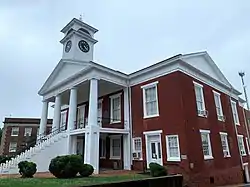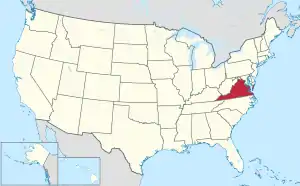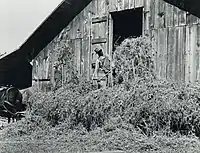Pittsylvania County, Virginia
Pittsylvania County is a county located in the Commonwealth of Virginia. As of the 2020 United States Census, the population was 60,501.[1] Chatham is the county seat.
Pittsylvania County | |
|---|---|
 | |
 Seal | |
 Location within the U.S. state of Virginia | |
 Virginia's location within the U.S. | |
| Coordinates: 36°49′N 79°24′W | |
| Country | |
| State | |
| Founded | 1767 |
| Named for | William Pitt |
| Seat | Chatham |
| Largest town | Chatham |
| Area | |
| • Total | 978 sq mi (2,530 km2) |
| • Land | 969 sq mi (2,510 km2) |
| • Water | 9 sq mi (20 km2) 0.9% |
| Population (2020) | |
| • Total | 60,501 |
| • Density | 62/sq mi (24/km2) |
| Time zone | UTC−5 (Eastern) |
| • Summer (DST) | UTC−4 (EDT) |
| Congressional district | 5th |
| Website | www |
Pittsylvania County is included in the Danville, VA Micropolitan Statistical Area.[2]
The largest undeveloped uranium deposit in the United States (7th largest in the world) is located in Pittsylvania County.[3] (see Uranium mining in Virginia.)
History
Originally "Pittsylvania" was a name suggested for an unrealized British colony to be located primarily in what is now West Virginia. Pittsylvania County would not have been within this proposed colony, which subsequently was named Vandalia.
Pittsylvania County was formed in 1767 with territory annexed from Halifax County. It was named for William Pitt, 1st Earl of Chatham, who served as Prime Minister of Great Britain from 1766 to 1768, and who opposed some harsh colonial policies of the period.
In 1777 the western part of Pittsylvania County was partitioned off to became Patrick Henry County.
Maud Clement's History of Pittsylvania County notes the following: "Despite the settlers' intentions, towns failed to develop for two reasons: the generally low level of economic activity in the area and the competition from plantation settlements already providing the kind of marketing and purchasing services typically offered by a town. Plantation settlements along the rivers, particularly at ferrying points, became commercial centers. The most important for early Pittsylvania was that of Sam Pannill, a Scots-Irishman, who at the end of the eighteenth century, while still a young man, set up a plantation town at Green Hill on the north side of the Staunton River in Campbell County. (Clement 15)
"Its economy was tobacco-dominated and reliant on a growing slave labor force. It was a county without towns or a commercial center. Plantation villages on the major river thoroughfares were the only centers of trade, until the emergence of Danville. (Clement 23)"
The city of Danville's history up through the antebellum period overall is an expression of the relationship between the town and the planters who influenced its development.
Geography

According to the United States Census Bureau, the county has a total area of 978 square miles (2,530 km2), of which 969 square miles (2,510 km2) is land and 9 square miles (23 km2) (0.9%) is water.[4] It is the largest county in Virginia by land area and second-largest by total area. The county is bounded on the north by the Roanoke River (this stretch of the river is known as the Staunton River), bisected by the Banister River running eastward through the center, and is drained on the south by the Dan River, flowing eastward.[5]
Districts
The county is divided into seven districts:
- Banister
- Callands-Gretna
- Chatham-Blairs
- Dan River
- Staunton River
- Tunstall
- Westover
Adjacent counties and cities
In Virginia:
- Bedford County - Northwest (across Smith Mountain Lake)
- Campbell County - North/Northeast
- Franklin County - West/Northwest
- Halifax County - East
- Henry County - West/Southwest
- Danville - South (independent city partially within borders of Pittsylvania County)
In North Carolina:
- Caswell County, North Carolina - South/Southeast
- Rockingham County, North Carolina - South/Southwest
Demographics
| Census | Pop. | Note | %± |
|---|---|---|---|
| 1790 | 11,579 | — | |
| 1800 | 12,697 | 9.7% | |
| 1810 | 17,172 | 35.2% | |
| 1820 | 21,323 | 24.2% | |
| 1830 | 26,034 | 22.1% | |
| 1840 | 26,398 | 1.4% | |
| 1850 | 28,796 | 9.1% | |
| 1860 | 32,104 | 11.5% | |
| 1870 | 31,343 | −2.4% | |
| 1880 | 52,589 | 67.8% | |
| 1890 | 59,941 | 14.0% | |
| 1900 | 46,894 | −21.8% | |
| 1910 | 50,709 | 8.1% | |
| 1920 | 56,493 | 11.4% | |
| 1930 | 61,424 | 8.7% | |
| 1940 | 61,697 | 0.4% | |
| 1950 | 66,096 | 7.1% | |
| 1960 | 58,296 | −11.8% | |
| 1970 | 58,789 | 0.8% | |
| 1980 | 66,147 | 12.5% | |
| 1990 | 55,655 | −15.9% | |
| 2000 | 61,745 | 10.9% | |
| 2010 | 63,506 | 2.9% | |
| 2020 | 60,501 | −4.7% | |
| US Decennial Census[6] 1790-1960[7] 1900-1990[8] 1990-2000[9] 2010[10] 2020[11] | |||
2020 census
| Race / Ethnicity | Pop 2010[10] | Pop 2020[11] | % 2010 | % 2020 |
|---|---|---|---|---|
| White alone (NH) | 47,250 | 44,277 | 74.40% | 73.18% |
| Black or African American alone (NH) | 13,963 | 12,354 | 21.99% | 20.42% |
| Native American or Alaska Native alone (NH) | 124 | 93 | 0.20% | 0.15% |
| Asian alone (NH) | 176 | 289 | 0.28% | 0.48% |
| Pacific Islander alone (NH) | 17 | 17 | 0.03% | 0.03% |
| Some Other Race alone (NH) | 42 | 128 | 0.07% | 0.21% |
| Mixed Race/Multi-Racial (NH) | 602 | 1,631 | 0.95% | 2.70% |
| Hispanic or Latino (any race) | 1,332 | 1,712 | 2.10% | 2.83% |
| Total | 63,506 | 60,501 | 100.00% | 100.00% |
Note: the US Census treats Hispanic/Latino as an ethnic category. This table excludes Latinos from the racial categories and assigns them to a separate category. Hispanics/Latinos can be of any race.
2010 Census
According to the 2010 United States Census, there are 60,949 people, and 26,687 households in the county. The population density was 65.5 people per square mile (25.3 people/km2). There were 31,656 housing units at an average density of 32 units per square mile (12 units/km2). The racial makeup of the county was 76.20% White, 21.50% Black or African American, 0.30% Native American, 0.50% Asian, 0.37% from other races, and 1.40% from two or more races. 2.70% of the population were Hispanic or Latino of any race.
There were 26,687 households, out of which 30.40% had children under the age of 18 living with them. The average household size was 2.28 and the average family size was 2.93.
The median income for a household in the county was $44,356. The per capita income for the county was $23,597. About 12.60% of the population were below the poverty line.
Government
Pittsylvania County is governed by an elected seven-member Board of Supervisors. Management of the county is vested in a Board-appointed County Administrator.
| Name | Party | First Election | District | |
|---|---|---|---|---|
| Robert 'Bob' Warren | Rep | 2015 | Chatham-Blairs | |
| Ronald 'Ron' Scearce | Rep | 2015 | Westover | |
| Nancy Eanes | Rep | 2023 | Dan River | |
| Tim Dudley (Vice Chair) | Rep | 2019 | Staunton River | |
| Darrell Dalton (Chair) | Ind | 2021 | Callands-Gretna | |
| William 'Vic' Ingram | Ind | 2019 | Tunstall | |
| Robert M. Tucker Jr. | Ind | 2022 | Banister | |
There are also five elected Constitutional Officers:
- Clerk of the Circuit Court: Mark Scarce (I)
- Commonwealth's Attorney: Robert Bryan Haskins (R)
- Sheriff: Michael "Mike" Taylor (I)
- Commissioner of Revenue: Robin Goard (I)
- Treasurer: Vincent Shorter (I)[12]
| Year | Republican | Democratic | Third party | |||
|---|---|---|---|---|---|---|
| No. | % | No. | % | No. | % | |
| 2020 | 23,751 | 69.39% | 10,115 | 29.55% | 361 | 1.05% |
| 2016 | 21,554 | 68.21% | 9,199 | 29.11% | 845 | 2.67% |
| 2012 | 19,263 | 62.78% | 10,858 | 35.39% | 560 | 1.83% |
| 2008 | 18,730 | 61.55% | 11,415 | 37.51% | 288 | 0.95% |
| 2004 | 17,673 | 64.46% | 9,274 | 33.83% | 470 | 1.71% |
| 2000 | 15,760 | 64.98% | 7,834 | 32.30% | 661 | 2.73% |
| 1996 | 12,127 | 55.85% | 7,681 | 35.37% | 1,906 | 8.78% |
| 1992 | 11,467 | 52.38% | 7,675 | 35.06% | 2,752 | 12.57% |
| 1988 | 12,229 | 63.69% | 6,612 | 34.44% | 360 | 1.87% |
| 1984 | 15,743 | 66.08% | 7,791 | 32.70% | 290 | 1.22% |
| 1980 | 12,022 | 59.28% | 7,653 | 37.74% | 605 | 2.98% |
| 1976 | 9,173 | 51.21% | 7,929 | 44.26% | 811 | 4.53% |
| 1972 | 12,108 | 72.34% | 4,429 | 26.46% | 200 | 1.19% |
| 1968 | 5,096 | 25.62% | 5,427 | 27.29% | 9,367 | 47.09% |
| 1964 | 7,120 | 57.54% | 5,228 | 42.25% | 25 | 0.20% |
| 1960 | 3,788 | 47.62% | 4,089 | 51.41% | 77 | 0.97% |
| 1956 | 2,870 | 36.82% | 4,136 | 53.07% | 788 | 10.11% |
| 1952 | 2,893 | 41.93% | 3,976 | 57.62% | 31 | 0.45% |
| 1948 | 1,164 | 20.54% | 3,149 | 55.58% | 1,353 | 23.88% |
| 1944 | 1,224 | 25.91% | 3,492 | 73.92% | 8 | 0.17% |
| 1940 | 728 | 16.34% | 3,710 | 83.28% | 17 | 0.38% |
| 1936 | 556 | 13.07% | 3,694 | 86.82% | 5 | 0.12% |
| 1932 | 656 | 17.08% | 3,124 | 81.35% | 60 | 1.56% |
| 1928 | 2,598 | 60.62% | 1,688 | 39.38% | 0 | 0.00% |
| 1924 | 880 | 24.75% | 2,563 | 72.08% | 113 | 3.18% |
| 1920 | 1,162 | 29.83% | 2,715 | 69.69% | 19 | 0.49% |
| 1916 | 801 | 28.08% | 2,012 | 70.52% | 40 | 1.40% |
| 1912 | 527 | 21.72% | 1,558 | 64.22% | 341 | 14.06% |
Communities
Census-designated places
Other unincorporated communities
- Ajax
- Bachelors Hall
- Banister
- Beaver Park
- Brosville
- Brights
- Brutus
- Buford
- Callahans Hills
- Callands
- Cartersville
- Cascade
- Cedar Forest
- Cedar Hill
- Chalk Level
- Climax
- Coles Hill
- Dry Fork
- Dundee
- Ebenezer
- Flint Hill
- Galveston
- Glenland
- Grady
- Green Acres
- Green Pond
- Greenfield
- Grit
- Henrys Mill
- Hermosa
- Hill Grove
- Hinesville
- Hollywood
- Hopewell
- Java
- Keeling
- Kentuck
- Lakewood
- Laniers Mill
- Laurel Grove
- Leaksville Junction
- Level Run
- Lucks
- Markham
- Motleys Mill
- Mount Airy
- Mount Cross
- Mountain Hill
- Museville
- Natal
- Peytonsburg
- Pickaway
- Pickerel
- Pittsville
- Pleasant Gap
- Pleasant Grove
- Pullens
- Ray
- Red Oak Hollow
- Redeye
- Renan
- Riceville
- Ridgeway
- Ringgold
- Rondo
- Sandy River
- Sharon
- Sheva
- Shockoe
- Soapstone
- Sonans
- Spring Garden
- Stony Mill
- Straightstone
- Sutherlin
- Swansonville
- Sycamore
- Tightsqueeze
- Toshes
- Transco Village
- Weal
- West Fork
- Whitfield
- Whitmell
- Whittles
- Witt
- Woodlake Park
- Woodlawn
- Worlds
- Vance
- Vandola
See also
References
- "Pittsylvania County, Virginia". US Census Bureau. Retrieved January 30, 2022.
- "Revised Delineations of Metropolitan Statistical Areas. " (PDF). Office Of Management and Budget. February 28, 2013. Archived (PDF) from the original on 9 October 2022. Retrieved February 8, 2015.
- Shulz, Max (26 July 2oo8). Virginia Is Sitting on the Energy Mother Lode. The Wall Street Journal. Accessed 27 July 2008.
- "US Gazetteer files: 2010, 2000, and 1990". US Census Bureau. 12 February 2011. Retrieved 23 April 2011.
- Ripley, George; Dana, Charles A., eds. (1879). . The American Cyclopædia.
- "Census of Population and Housing from 1790-2000". US Census Bureau. Retrieved January 24, 2022.
- "Historical Census Browser". University of Virginia Library. Retrieved January 4, 2014.
- "Population of Counties by Decennial Census: 1900 to 1990". US Census Bureau. Retrieved January 4, 2014.
- "Census 2000 PHC-T-4. Ranking Tables for Counties: 1990 and 2000" (PDF). US Census Bureau. Archived (PDF) from the original on 9 October 2022. Retrieved January 4, 2014.
- "Hispanic or Latino/Not Hispanic or Latino by Race - 2010: DEC Redistricting Data (PL 94-171) - Pittsylvania County, Virginia". US Census Bureau.
- "Hispanic or Latino/Not Hispanic or Latino by Race - 2020: DEC Redistricting Data (PL 94-171) - Pittsylvania County, Virginia". US Census Bureau.
- "Elected Officials - Pittsylvania County, VA - Official Website". www.pittsylvaniacountyva.gov. Retrieved 17 November 2022.
- Leip, David. "Atlas of US Presidential Elections". uselectionatlas.org. Retrieved 9 December 2020.